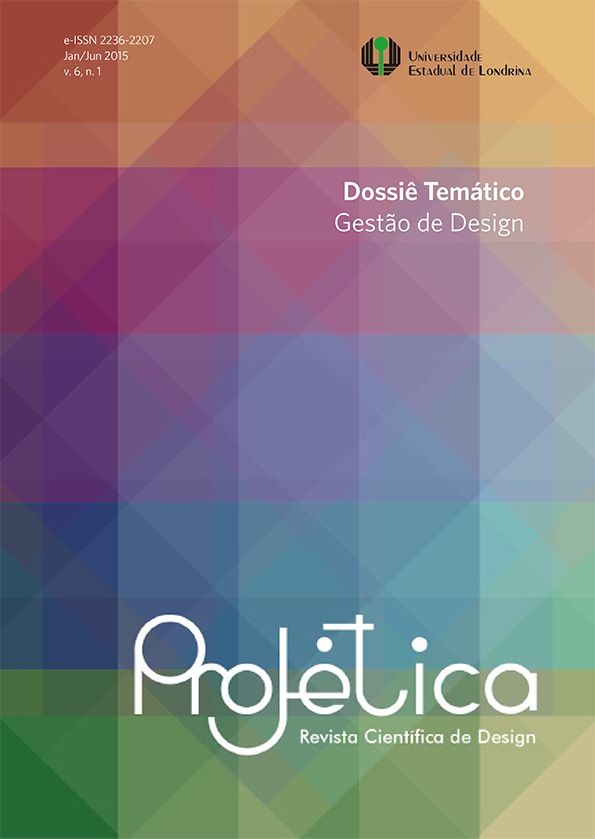Design and Ergonomics: Demands Identification Bases
DOI:
https://doi.org/10.5433/2236-2207.2015v6n1p39Keywords:
Ergonomics, Design, Creative CommunityAbstract
This article presents the ergonomic analysis of work in a creative community that is engaged in carpet weaving on handlooms. The ergonomic analysis started from the user interaction with the loom, in which the design acts through the representation of the system involving the work situation. Through a methodology of ergonomic analysis, this study presents the diagnosis of existing demands and proposes an improvement in the workplace, in order to contribute to the quality of life of artisans bringing to it their sociocultural context.
Downloads
References
BONSIEPE, G.; DUTRA, C. Design: do material ao digital. Florianópolis: FIESC/ IEL, 1997.
CARLI, A. M. S. et. al. Design e artesanato: novidade e tradição, um diálogo possível. Redige, v. 2, n. 2, p. 430-444, 2011.
CONSELHO NACIONAL DO AMBIENTE E DO DESENVOLVIMENTO SUSTENTÁVEL. Comentário do CNADS sobre o “Relatório de Factores Críticos da Avaliação Ambiental Estratégica” das propostas [...] e Directiva Europeia 2001/42/CE. Disponível em: http://www.cnads.pt/index.php?option=com_docman&task=cat_view&gid=52&Itemid=84. Acesso em: 12 ago. 2014.
DUL, J.; WEERDMEESTER, B. Ergonomia na prática. Tradução ItiroIIda. São Paulo: Edgard Blücher, 2004.
GOMES FILHO, J. Design do objeto: bases conceituais. São Paulo: Escrituras, 2006.
GUÉRIN, F. et al. Compreender o trabalho para transformá-lo: a prática da ergonomia. São Paulo: Edgard Blücher: Fundação Vanzolini, 2001. INTERNATIONAL ERGONOMICS ASSOCIATION. Definition and Domains of ergonomics. Disponível em: http://www.iea.cc/whats/index.html. Acessado em: 28 mar. 2014.
JORDAN, P. W. et al. Usability evaluation in industry. London: Taylor & Francis, 1996
KRUCKEN, L. Design e território: valorização de identidades e produtos locais. São Paulo: Studio Nobel, 2009.
LANDIM, P.D.C. Design, empresa, sociedade. São Paulo: Cultura Acadêmica, 2010
MANZINI, E. Design para a inovação social e sustentabilidade: comunidades criativas, organizações colaborativas e novas redes projetuais. 2008. Disponível em: http://www.e-papers.com.br. Acessado em: 1 ago. 2014.
MARTINS, R. F. F; MERINO, E. A. D. Gestão de Design como estratégia organizacional. 2. ed. Londrina: EDUEL, 2011.
MERINO, E. A. D. Fundamentos da ergonomia. Florianópolis: UFSC, 2011. Apostila.
MERONI, A. Creative Communities: People inventing sustainable way sof living. Milano: Edizioni Polidesign, 2007.
ORGANIZAÇÃO DAS NAÇÕES UNIDAS. Declaração do Rio sobre Meio Ambiente e Desenvolvimento. 1992. Disponível em:<http://www.onu.org.br/rio20/para-alem-do-pib-pnud-propoe-indice-de-desenvolvimento-humanosustentavel/.> Acesso em: 28 mar. 2014.
PASCHOARELLI, L.C; MENEZES, M.S. (Org.). Design: questões de pesquisa. Rio de Janeiro: Rio Book’s, 2010.
PIZO, C. A.; MENEGON, N.L. Análise ergonômica do trabalho e o reconhecimento científico do conhecimento gerado. Produção, v.20, n.4, out/dez. 2010. Disponível em: http://prod.org.br/files/v20n4/v20n4a12.pdf.
Acesso em: 1 ago. 2014
RODRIGUES, R.F.; MERINO, E.A.D.; CASAROTTO FILHO, N. Contribuição da ergonomia no processo de inovação das instituições. Ação Ergonômica, v. 8, n.1, p. 24-32, 2013. Disponível em: http://www.abergo.org.br/revista/index.php/ae/issue/view/19. Acesso em:28 mar. 2014.
SALDANHA, M. C. W. et al. Ergonomia e sustentabilidade na atividade jangadeira: construção das demandas ergonômicas na praia de Ponta Negra – RN. Ação Ergonômica, v. 7, n.1, p. 101–121, 2012 . Disponível em: http://www.abergo.org.br/revista/index.php/ae/ article/view/133. Acesso em: 28 mar. 2014.
SANTOS, N.; FIALHO, F. A. P. Manual de Análise Ergonômica no Trabalho. Curitiba: Gênesis Editora, 1995.
STANTON, N. A.; BARBER, C. Factors affecting the selection of methods and techniques prior to conducting a usability evaluation. In: JORDAN, P. W. et al. Usability evaluation in industry. London: Taylor & Francis, 1996. p. 39-48.
STANTON, N. A. Human in Factors in Consumer Products. Bristol: CRC Press, 2003.
Downloads
Published
How to Cite
Issue
Section
License
Projética está licenciada sob a Creative Commons Attribution CC-BY 4.0 International. Os autores detém os direitos autorais e concedem à revista o direito de exclusividade de primeira publicação.
Os autores dos trabalhos aprovados autorizam Projética a, após a publicação, ceder seu conteúdo para reprodução em indexadores de conteúdo, bibliotecas virtuais e similares.
Os autores assumem que os textos submetidos à publicação são de sua criação original, responsabilizando-se inteiramente por seu conteúdo em caso de eventual impugnação por parte de terceiros. As opiniões emitidas pelos autores dos artigos são de sua exclusiva responsabilidade.
A revista se reserva o direito de efetuar, nos originais, alterações de ordem normativa, ortográfica e gramatical, com vistas a manter o padrão culto da língua e a credibilidade do veículo. Respeitará, no entanto, o estilo de escrever dos autores. Alterações, correções ou sugestões de ordem conceitual serão encaminhadas aos autores, quando necessário. Nesses casos, os artigos, depois de adequados, deverão ser submetidos a nova apreciação. As provas finais não serão encaminhadas aos autores.











